Munich High End 2023 Show Highlights
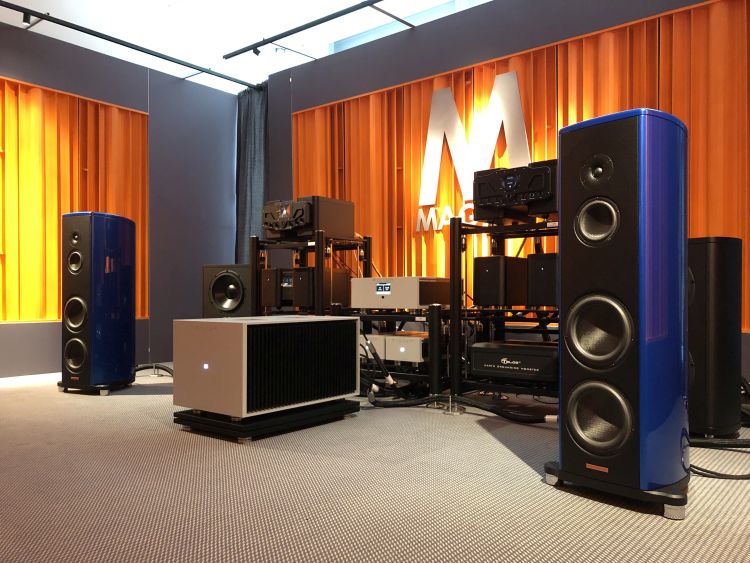
Stein
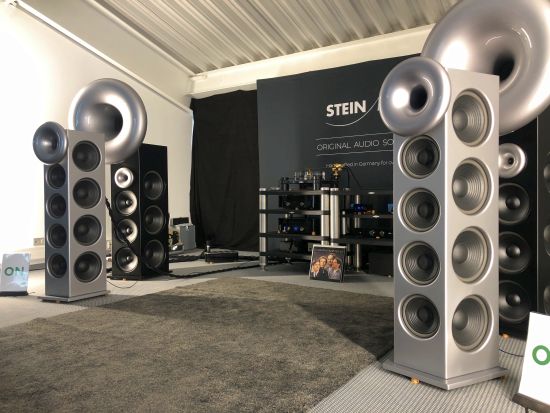
I don’t know how they do it, but every time I hear Stein speakers, they manage to sound nimble, coherent, fast, light-footed, and expressive, in spite of using what seems like an excessive number of drivers. Although the horn is not audibly invisible (which to be fair is nigh-on impossible), I still felt that together with Seawave Acoustic speakers, this Topline Bob M model provided a really great representation of the species.
Grimm Audio
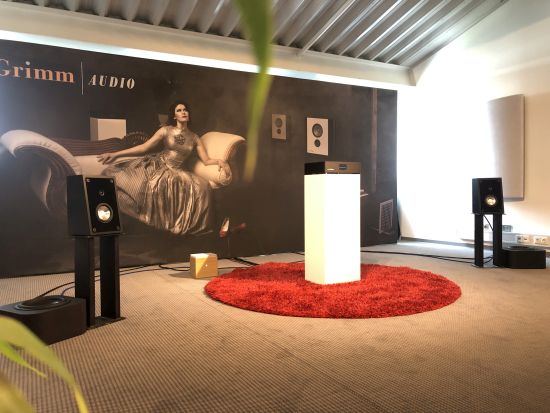
So far, we’ve seen bigger and bigger systems that look impressive but Grimm Audio decided to do things differently. Amazingly, this unassuming system managed to sound incredibly large! When I walked in, the music was already playing and I had no idea what these speakers were. What I did know was that we were listening to the new MU2 which, in a nutshell, is the MU1 with an on-board proprietary DAC. Grimm Audio of course have their LS-1 active digital speaker system but given the MU2’s analog outputs, it is of course best demoed with analog speakers and an analog amplifier.
The MU2 combines a music streamer with a DAC and analog pre-amp. Its built-in DAC takes full advantage of the Grimm Audio low jitter clock and high-performance FPGA processor. A relay-based analog volume control enables the MU2 to become the center ‘hub’ of a hifi system for both digital and analog sources. Just as with its sister product, the “digital output” MU1, a Roon Labs Core server is on board so no external computer is needed.
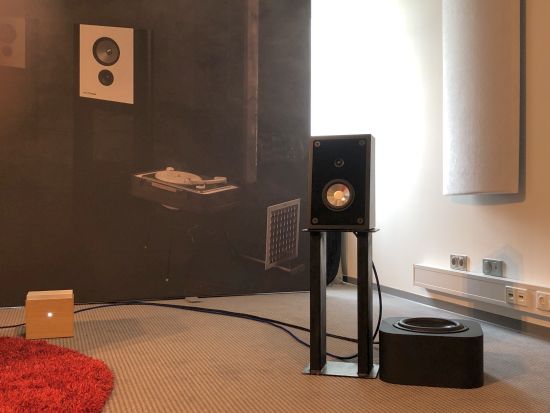
When co-designer Guido Tent later addressed the public, he explained that they intentionally opted to use such diminutive speakers (30-year old Ensembles) so that the attention would move to the MU2 rather than whichever extravagant speaker they could have selected. That’s a very fair point, I have to say. But more importantly, the sound coming from this mini-system (aided by Grimm subwoofers and powered by prototype Grimm non-memory-effect amplifiers) was remarkably good. Scale, resolution, refinement, flow, emotional involvement, dynamics, soundstage, it was all tip-top!
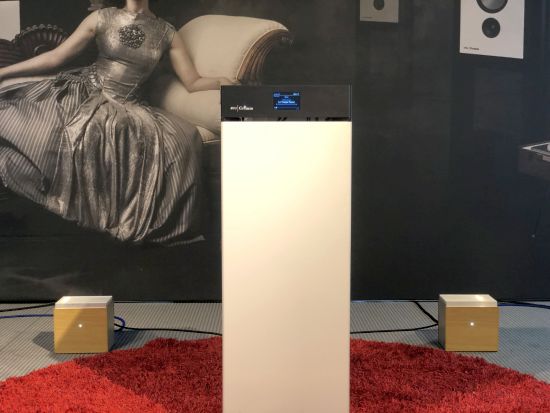
With these unknown speakers and amplifiers and without direct comparison, it will be hard to draw any hard conclusions but my feeling is that the MU2 may be something special indeed.
Kroma Atelier / Artesania with APL and VAC
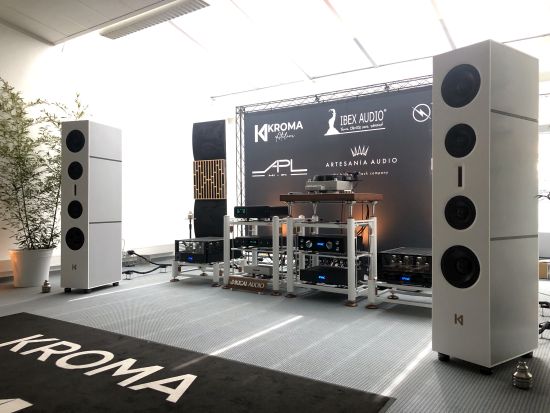
These beautiful Kroma Atelier Mercedes speakers reminded me sonically of the Kroma Elektra and Carmen which is to say they sound full-bodied, rich, smooth, and organic, but with airier and more delicate treble, thanks to the ribbon driver.
It was a sweet sweet sound, very easy to listen to, but warmer and more relaxed than I am accustomed to from other Kroma presentations. Maybe it was the room, the racks, or a room interaction, but it was a little too relaxed for my taste. On the other hand, this system is great for unwinding from a busy day visiting a crowded and loud audio show:-)
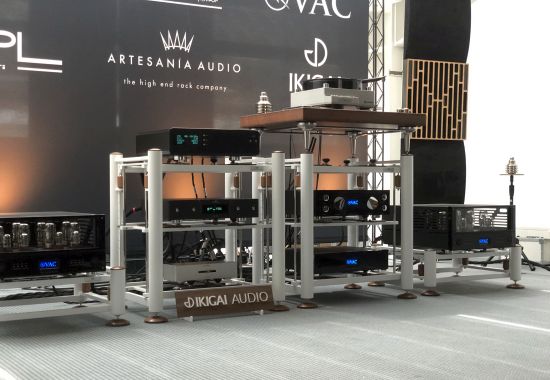
Artesania Audio showcased a range of new products:
- Exoteryc Rack Panzerholz Edition
- Exoteryc Rack Pro (as also seen in the Magico room, among others)
- Ki Rack
Exoteryc Rack Panzerholz Edition
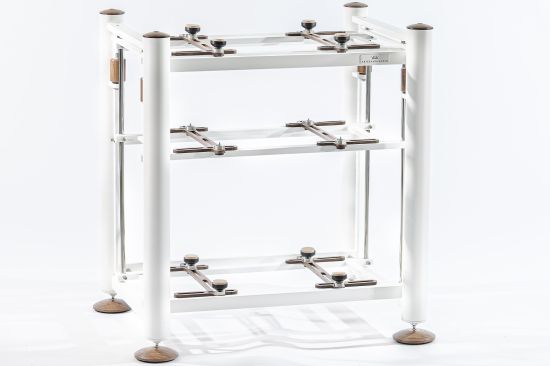
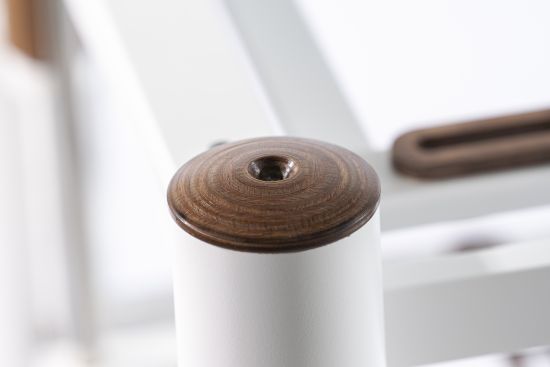
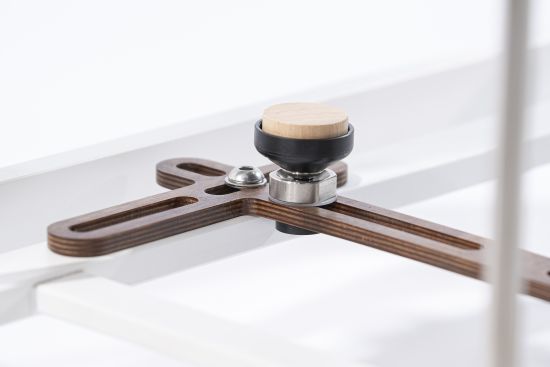
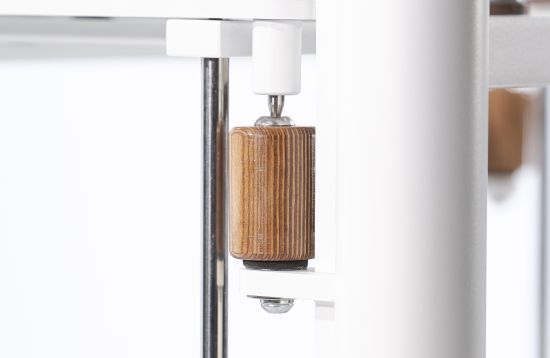
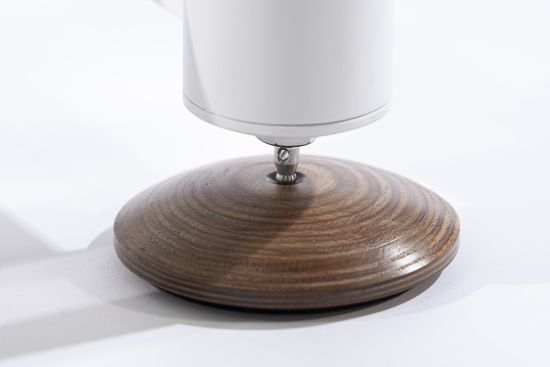
Exoteryc Rack Pro
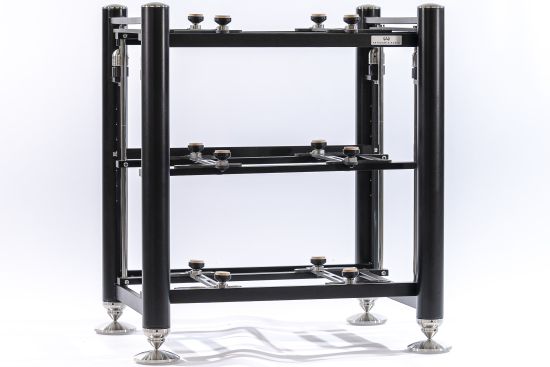
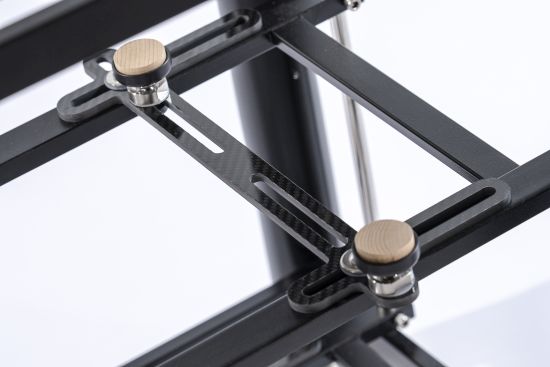
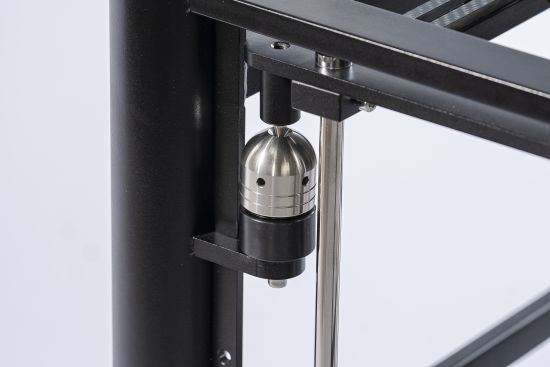
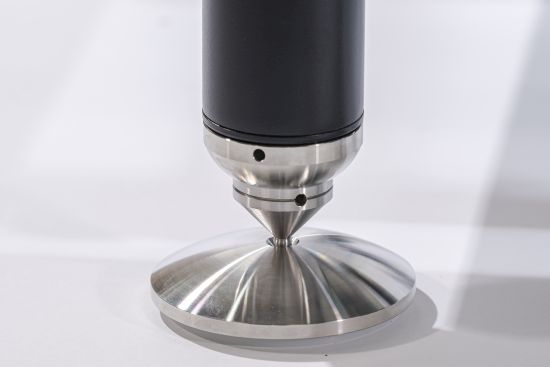
Ki Rack
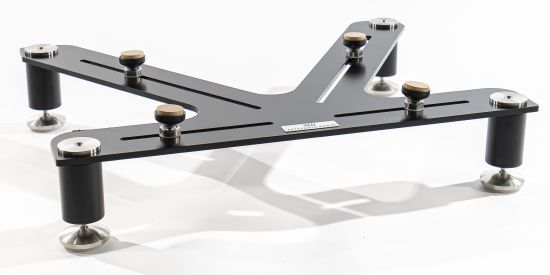
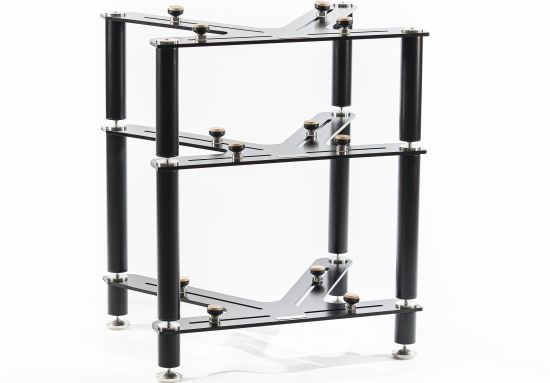
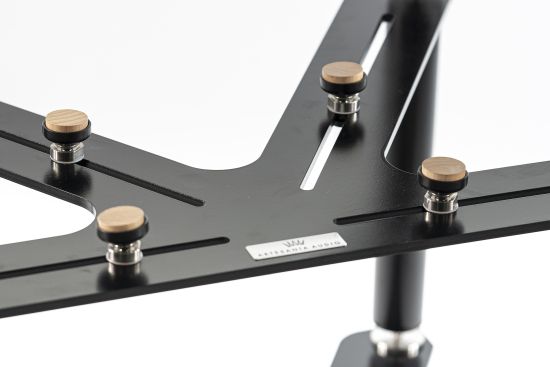
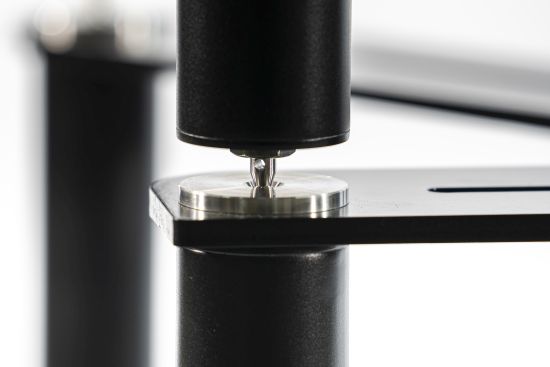
Next: Diptyque with B.audio

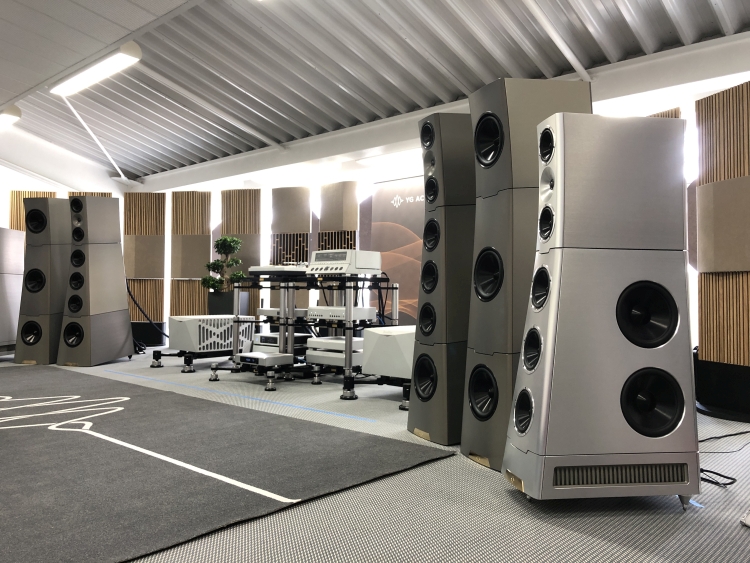



Hi Christiaan,
just read your impressions: well written as always.
The visit to the Marriott, the big Marco Serri loudspeakers… and the big electronics so “fluid” and “harmonic”… transparent, coherent, linear, open, delicate and airy and the bass was deep but agile, very precise and absolutely never overbearing (your words)…
Guess how the hall was “prepared” (wired)
😉
Keep it up!
Thanks, Luca:-) I have not noticed the cable brand(s) in the Marco Serri system, but I’m now thinking maybe it was Faber’s cable?
Hi all, we confirm the wiring and setup were by Faber’s Cables, which we publicly thank for their contribution
Marco Serri Design
You win!
:))
Without wanting to do “free propaganda” here, as you could hear and despite the “massive” speakers and a complex system, in a hotel room that was not perfectly “adequate”, the sound was “graceful”, especially the digital one.
Better than a thousand words (practically “blindly”), you tried what I told you about the ground connection, the masses and so on.
Ask me more… “privately”…
😉
Thank you
Hi Christiaan,
I really enjoy reading your HFA commentary. You have a talent for making complex topics easy to understand and a real gift for describing in language something as indescribable as music.
In your recent show report about the Taiko/Alsyvox room you wrote, “But I’ll add that no one will ever mistake them for, say, Wilson Audio speakers. These are just very different breeds.”
Would you care to expand on this? I’ve never heard the Alsyvox speakers though in the past and very distant past I’ve owned Magnaplanar planar magnetics and Acoustat electrostatics. I do however own Wilson Alexx speakers, so I’m familiar with Darryl Wilson’s sound (I have to say, I was never in love with his father Dave’s designs’ sound signature). To triangulate further with what else I’m familiar with in the high-end, prior to the Alexx I lived with Sonus Faber Aidas for some years.
Thanks very much,
Steve Z
Hi Steve, thanks for the kind words!
I’ve taken Wilson as an example as they are a well-known and iconic brand and because in my mind, they are in many ways diametrically opposed to the typical dipole magnetostatic ribbon panel sound.
Speaking from experience having owned Wilson WP8 and having heard other older, newer, and current Wilsons in various places in the Netherlands, I find that these speakers tend to sound rather fulsome in the bass, especially the upper bass. This is true in relatively large (for Dutch terms) spaces and usually more so in smaller spaces. In part this may be by design, but it might also partially be a result of the speakers being developed primarily for American residences which tend to be large and constructed in large part from wood and drywall. In the Netherlands, these speakers are used in relatively small rooms with concrete floors and walls which often create rather serious room modes that are hard to address, especially when using Wilsons. This can lead to a relatively bombastic sound that I know many people actually enjoy and might perceive as natural. I will gladly admit that there is indeed a very nice “live” aspect to the Wilson sound that I quite enjoy.
Naturally, it’s of course not just Wilson that can interact quite strongly with room modes but basically all dynamic speakers and predominantly the ported ones. What also made me use Wilson as an example is that after enjoying Magnepan, Apogee, and Martin Logan speakers with no issues, I was sadly unable to get my Wilsons to sound linear in my inherently imperfect room, which made me move on to closed cabinet speakers, currently Magicos, which work much better in my then-rather challenged environment.
So, how does this relate to magnetostatic ribbon speakers? Well, due to their dipole in-phase/out-of-phase nature and figure-of-8-radiation pattern, speakers of this kind tend to agitate room modes very significantly less so. So much so, in fact, that one could be entirely unaware of existing acoustical issues in a given room, when using Magnepan, Apogee, Diptyque, Analysis, or indeed Alsyvox speakers.
If one is not accustomed to the sound of truly clean bass, hearing it for the first time from a speaker like the aforementioned dipoles may lead one to believe the sound is lean, thin, lacking body, or tonality. While some of the aforementioned brands could objectively indeed be regarded to sound less full-bodied, robust, and tonally saturated as the average well-designed dynamic speaker, I can’t accuse Alsyvox of any of this. To me, they sound very realistic and actually achieve a balance that is as close to neutral as I have heard it from a speaker. To a large extent, you can think of ribbon speakers as listening to headphones. There will be deep, articulate, precise bass, and it can even be rather powerful, but it won’t be the same as from a big dynamic speaker. Now image that “ideal” headphone sound and extrapolate it to coming from a speaker, but with greater dynamic impact. That’s how I would describe the Alsyvox speakers.
Ultimately, though, and this is the point of the comparison that I was making in the show report, I would propose that none of the panel speakers mentioned will sound quite as voluptuous, gut-wrenching, and full-bodied as a Wilson, even when the latter is setup in an ideal room. In the end, it is to some extent a relative matter and that’s what I was trying to convey.
Thanks very much for taking the time, Christiaan. Very helpful, as always!
Great commentary as usual, it’s interesting what you say about the new Magico’s S3’s having heard a variety of Magicos over the years i find them a bit cold in places. Obviously amplification plays a big role in this but will be interesting to hear what they are like in a ones listening space. I sadly didn’t get into this room too much to see in one day. Agree on the Wilsons, impressive in a big space, but more cut out for the US market.
Did you get to the TIDAL room? that was best for me that i heard all day, especially the Tidal for Bugatti. Different level in my book to most things there, first time on hearing this. Not sure about the totally polished cabinets but the sound was amazing.
keep up the good work! love reading the reviews.
Miami
Hi Miami, The assessment of the quality/beauty/realism of sound reproduction really is quite personal. I believe that since hifi is inherently never a perfect representation of reality, we as individuals choose which aspects of the sound reprodution we associate with being appealing or sounding realistic. To me, these may be a different set of aspects than to you, or someone else. I know that there are people who find Magicos to sound relatively cold. To a large extent, I think this is based on listening to Q-series models which are indeed incredibly revealing and can be fussy. I would not label S-series and M-series Magicos as cold, but I know that there are people who still hear them as such. The new S3 sounds to me like a hybrid between the S-series, Q-series, and M-series. It has exrtremely low coloration and distortion, and as demonstrated in Munich this year, the speaker can sound remarkably clean and coherent. To an extent, this is also the result of cleverly used subs and considerably more ideal room conditions than normal. But what I found particularly compelling was that there was never any edge or hardness and the speakers managed to sound fast and accurate as well as gentle and refined. Ultimately, the assessment of what constitutes great sound is in the ears of the beholder and it remains a matter of perspective and of personal preference. The variety of preferences and methods of reproduction, and the quest for finding the ever more ideal balance, is what keeps it interesting:-) Alas, the Bugatti was not playing when I visited the Tidal room.